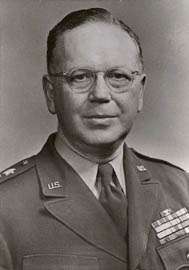Henry Aurand
Henry S. Aurand (November 16, 1894 – 1980) was a United States Army career officer. He was a veteran of World War I, World War II and the Korean War. Aurand served in the Coastal Artillery branch. He later transferred to the Ordnance Corps.
Henry Spiese Aurand | |
|---|---|
 Lieutenant General Henry S. Aurand | |
| Born | April 21, 1894 Tamaqua, Pennsylvania |
| Died | June 18, 1980 (aged 86) Laguna Hills, California |
| Buried | |
| Allegiance | |
| Service/ | |
| Years of service | 1915–1952 |
| Rank | |
| Commands held | |
| Battles/wars | |
| Awards |
|
| Relations | Evan Peter Aurand |
Education
Henry Aurand attended the United States Military Academy and was a member of the class of 1915, "the class the stars fell on". During his military career he went on to attend the Army Ordnance School (1916), the Command and Staff College (1928), the Army War College (1931), and the Army Industrial College (1940).
World War I
He served at Sandy Hook Proving Ground from 1917 to 1919.
Between the wars
Aurand served in a variety of positions prior to World War II. Leading up to the war he attended military schools and developed an expertise in logistics. As early as the mid-1930s, he began to use principles of logistics that are still in use today.
In 1920, he formally transferred to the Ordnance Corps. He served in the Philippines from 1925 to 1927. He served on the faculty of the Ordnance School at Watertown Arsenal from 1929 to 1930. From 1933 to 1939, he was an instructor for logistics at the Army War College.
World War II
Aurand's professional preparation paid off during World War II. He was tasked with a number of demanding high-profile commands. In 1941, he was the Director of Defense Aid, the program that sent Lend Lease materials to the Allies. After that position, he became the Chief of the International Division, Army Service Forces in 1942 and later that year he became the Secretary of the Combined Production Board. He finished 1942 as the Commanding General of the Sixth Service Command in Chicago, Illinois.
In 1944, Aurand was assigned as the Assistant Chief Ordnance Officer, European Theater of Operations (ETOUSA) and Communications Zone (ComZ). He moved to become the Commanding General, Normandy Base Section, ComZ, ETOUSA, later that year. In 1945, he was the last Commanding General, United States Services of Supply, China Theater (US SOS CT).
Post-war and retirement
Aurand returned to the United States as the Commanding General of the Sixth Service Command, a position he had held during the war. Likewise he was again the last commander of a theater of operations for the U.S. Army, the Africa-Middle East Theater in 1946. To close 1946, he was the last Director of Research and Development, War Department.
In 1947, Aurand became the Director of Logistics, Department of the Army, and, in 1949, Commanding General, United States Army, Pacific (CG USArPac), a position he held until his retirement in 1952 when he was replaced by John W. O'Daniel.[1]
He died in 1980.
Legacies and accomplishments
Lieutenant General Aurand's accomplishments during his career were diverse and wide-ranging. The impact of some of his actions were fundamental to the success of the United States military during World War II and the Korean War.
He reshaped the U.S. military's logistics philosophy in many ways. For example, he convinced army planners to first calculate logistics capabilities before determining operational plans. Prior to this, planning had begun with operations and then logistics had been examined to see if they could support the operational plan. Other examples of his revisionist thinking were his two principles of logistics, "Troops in action should never have to turn their backs on the enemy to fetch further supplies" and "Troops should not be encumbered with supplies beyond immediate needs".
He made extensive use of black supply troops in the ETO. He believed that they could be as effective as any other group of soldiers provided their officers were allowed to act with the same authority as white troops. The success of the U.S. Army logistical operation in Europe, especially during the race across France in the fall of 1944 and the Battle of the Bulge during the winter of 1944 to 1945 proved Aurand correct.
He was instrumental in the acquisition of the 1/4 ton general purpose vehicle, the Jeep.
He was one of the first to realize the importance of using computers in supply management when he saw them used during the Louisiana Maneuvers. When he was appointed the commander of the Normandy Base Section, he had all ammunition requirements entered onto punchcards for computer entry.
Further reading
- BIGGEST WEST POINT CLASS JOINS ARMY, New York Times, June 13, 1915
- Donald W. Whistenhunt, The Human Tradition in America Between the Wars, 1920-1945, Rowman & Littlefield, 2002, pages 185-201, ISBN 0842050124.
References
- "Pacific Commander To Retire In August". Eugene Register-Guard. June 22, 1952. Retrieved May 7, 2015.
External links
- Arlington Cemetery retrieved May 11, 2009
- Nomination for Ordnance Corps Hall of Fame retrieved May 11, 2009